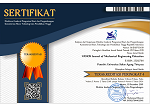MICROSTRUCTURAL AND MECHANICAL PROPERTIES AL 6061 PROCESSED BY COLD ROLLING AND AGING
Abstract
An Alumunium alloy 6061was produced by cold rolling and subsequently aging. Cold rolling is used for reducing grain size and aging is used for producing second-phase, thus improving hardness, strength and wear resistance. In the present paper, a process through cold rolling with reduction of 50%, 60% and 70% in thickness then aged at 2000C for 1.800, 3.600, 5.400, 7.200 and 10.800 sec. Microstructural analysis shows that the grain morphology consists of equaxied grain for as-received samples and elongated grain for sample after cold roll and aging. X-Ray Diffraction (XRD) analysis showed peaks phases in Al 6061 after cold rolled and aging. Hardness measurements showed that combination between small grain size and presence of second-phase led to a significant increase in the hardness. Maximum hardness of 121 HBN is achieve for sample after cold roll 70% and aged for 5400 second. The wear resistance testing showed that lost particles of 6,209951 x 10-6 mm3/mm for received sample and 4,775436 x 10-6 mm3/mm for sample after aging process. It is showed that high hardness related to increase the wear resistance. It is reasonable that the presence of second phases are function as obstacle for dislocation movement.
Keywords
Full Text:
PDFReferences
Alhamidi, Ali, et al. "Softening by severe plastic deformation and hardening by annealing of aluminum–zinc alloy: Significance of elemental and spinodal decompositions." Materials Science and Engineering: A 610 (2014): 17-27.
Alhamidi, Ali, Kaveh Edalati, and Zenji Horita. "Production of nanograined intermetallics using high-pressure torsion." Materials Research 16.3 (2013): 672-678.
Demir, Halil, and Süleyman Gündüz. "The effects of aging on machinability of 6061 aluminium alloy." Materials & Design 30.5 (2009): 1480-1483.
De Silva, G. I. P., and W. C. Perera. "Improvement of the Mechanical Properties of Aluminum 6063 T5 Extrudates by Varying the Aging Condition Cost-Effectively." SAITM Research Symposium on Engineering Advancements (SAITM–RSEA 2012). 2012.
Ilangovan, M., S. Rajendra Boopathy, and V. Balasubramanian. "Microstructure and tensile properties of friction stir welded dissimilar AA6061–AA5086 aluminium alloy joints." Transactions of Nonferrous Metals Society of China 25.4 (2015): 1080-1090.
Kim, H. H., S. H. Cho, and C. G. Kang. "Evaluation of microstructure and mechanical properties by using nano/micro-indentation and nanoscratch during aging treatment of rheo-forged Al 6061 alloy." Materials Science and Engineering: A 485.1 (2008): 272-281.
Mrówka-Nowotnik, G. "Influence of chemical composition variation and heat treatment on microstructure and mechanical properties of 6xxx alloys."Archives of materials science and engineering 46.2 (2010): 98-107.
Muruganandam, D., S. Ravikumar, and S. L. Das. "Mechanical and micro structural behavior of 2024–7075 aluminium alloy plates joined by friction stir welding." Frontiers in Automobile and Mechanical Engineering (FAME), 2010. IEEE, 2010
Ozturk, F., et al. "Influence of aging treatment on mechanical properties of 6061 aluminum alloy." Materials & Design 31.2 (2010): 972-975.
Pramono, A., Milandia, A., Nugraha, K., & Fawaid, M. (2017). ALUMINUM ALLOYS BY ECAP CONSOLIDATION FOR INDUSTRIAL APPLICATION. VANOS Journal of Mechanical Engineering Education, 2(2).
Qosim, N., & Adzhani, S. (2017). GRAIN REFINEMENT TECHNIQUES TO REDUCE BIODEGRADATION RATE OF MAGNESIUM ALLOY AS A POTENTIAL BIODEGRADABLE IMPLANT MATERIAL: A REVIEW. VANOS Journal of Mechanical Engineering Education, 2(2).
Rezaei, Mohammad Reza, Mohammad Reza Toroghinejad, and Fakhreddin Ashrafizadeh. "Production of nano-grained structure in 6061 aluminum alloy strip by accumulative roll bonding." Materials Science and Engineering: A529 (2011): 442-446.
Risanti, D. D., et al. "A systematic study of the effect of interrupted ageing conditions on the strength and toughness development of AA6061."Materials Science and Engineering: A 523.1 (2009): 99-111.
Su, Lihong, et al. "Ultrafine grained AA1050/AA6061 composite produced by accumulative roll bonding." Materials Science and Engineering: A 559 (2013): 345-351.
Tan, Evren, and Bilgehan Ögel. "Influence of heat treatment on the mechanical properties of AA6066 alloy." Turkish Journal of Engineering and Environmental Sciences 31.1 (2007): 53-60.
Toroghinejad, Mohammad Reza, Fakhreddin Ashrafizadeh, and Roohollah Jamaati. "On the use of accumulative roll bonding process to develop nanostructured aluminum alloy 5083." Materials Science and Engineering: A561 (2013): 145-151.
DOI: http://dx.doi.org/10.30870/vanos.v3i1.3686
Refbacks
- There are currently no refbacks.

This work is licensed under a Creative Commons Attribution 4.0 International License.


.png)
.png)
